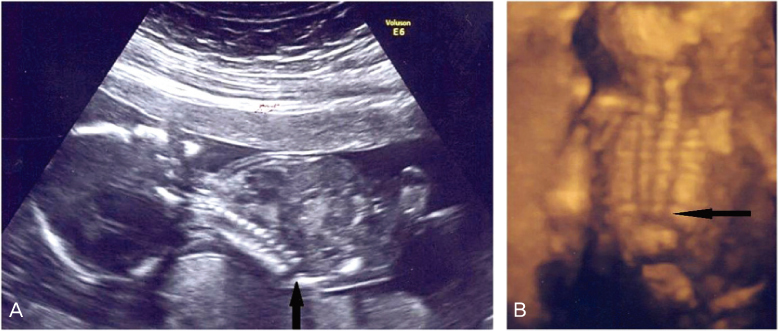Korean J Obstet Gynecol.
2011 May;54(5):265-268. 10.5468/KJOG.2011.54.5.265.
Prenatal diagnosis of caudal regression syndrome: A case report
- Affiliations
-
- 1Department of Obstetrics and Gynecology, Gyeongsang National University School of Medicine, Jinju, Korea. wypaik@gnu.ac.kr
- 2Gyeongsang Institute of Health Sciences, Gyeongsang National University, Jinju, Korea.
- KMID: 2078023
- DOI: http://doi.org/10.5468/KJOG.2011.54.5.265
Abstract
- Caudal regression syndrome is rare congenital defect, characterized by the absence of the sacrum, and defects of variable portion of lumbar spine, associated with anomalies from different systems. Although hyperglycemia related to maternal diabetes, genetic predisposition, teratogens, and vascular anomalies altering blood flow have been hypothesized to play a role in its pathogenesis, but the cause of this rare condition is not clear. We report a case of caudal regression syndrome diagnosed by prenatal ultrasonography at 16 weeks of gestation.
MeSH Terms
Figure
Reference
-
1. Duhamel B. From the mermaid to anal imperforation: the syndrome of caudal regression. Arch Dis Child. 1961. 36:152–155.2. Jaffe R, Zeituni M, Fejgin M. Caudal regression syndrome. Fetus Spinal Anomalies. 1991. 7561:1–3.3. Rojansky N, Fasouliotis SJ, Ariel I, Nadjari M. Extreme caudal agenesis. Possible drug-related etiology? J Reprod Med. 2002. 47:241–245.4. Subtil D, Cosson M, Houfflin V, Vaast P, Valat A, Puech F. Early detection of caudal regression syndrome: specific interest and findings in three cases. Eur J Obstet Gynecol Reprod Biol. 1998. 80:109–112.5. Hirano H, Tomura N, Watarai J, Kato T. Caudal regression syndrome: MR appearance. Comput Med Imaging Graph. 1998. 22:73–76.6. Kucera J. Rate and type of congenital anomalies among offspring of diabetic women. J Reprod Med. 1971. 7:73–82.7. Reece EA, Homko CJ. Why do diabetic women deliver malformed infants? Clin Obstet Gynecol. 2000. 43:32–45.8. Singh SK, Singh RD, Sharma A. Caudal regression syndrome: case report and review of literature. Pediatr Surg Int. 2005. 21:578–581.9. Wang J, Spitz L, Hayward R, Kiely E, Hall CM, O'Donoghue DP, et al. Sacral dysgenesis associated with terminal deletion of chromosome 7q: a report of two families. Eur J Pediatr. 1999. 158:902–905.10. Rodríguez L, Sanchís A, Villa A, Cánovas A, Peris S, Estívalis M, et al. Ring chromosome 7 and sacral agenesis. Am J Med Genet. 2000. 94:52–58.11. Bashiri A, Sheizaf B, Burstein E, Landau D, Hershkovitz R, Mazor M. Three dimensional ultrasound diagnosis of caudal regression syndrome at 14 gestational weeks. Arch Gynecol Obstet. 2009. 280:505–507.12. Twickler D, Budorick N, Pretorius D, Grafe M, Currarino G. Caudal regression versus sirenomelia: sonographic clues. J Ultrasound Med. 1993. 12:323–330.13. Moon Y, Kim JH, Ahn OJ, Jeon SW, Hwang BC. A case of caudal regression syndrome diagnosed by prenatal ultrasonography. Korean J Obstet Gynecol. 2005. 48:1788–1792.
- Full Text Links
- Actions
-
Cited
- CITED
-
- Close
- Share
- Similar articles
-
- A Case of Caudal Regression Syndrome Diagnosed by Prenatal Ultrasonography
- A Case of Caudal Regression Syndrome in the Newborn of the Diabetic Mother
- Prenatal diagnosis of 5p deletion syndrome: A case series report
- Prenatal Sonographic Findings of Beckwith-Wiedemann Syndrome: A Case Report
- Prenatal diagnosis of 4p deletion syndrome: A case series report



